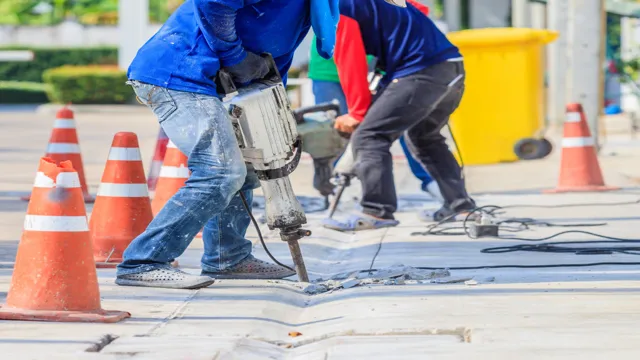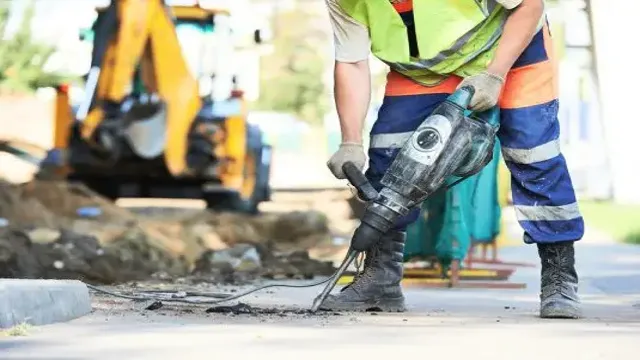How Loud Is a Jackhammer? Decibel Levels and Safety Tips Explained

Have you ever been disturbed by a loud jackhammer and wondered just how loud it is? Well, wonder no more! The noise level of a jackhammer is one of the most common complaints among construction sites and roadworks. The deafening sounds can shake the ground and rattle your eardrums. It’s no surprise that many workers and residents in the area find it unbearable.
So, just how loud is a jackhammer, and is there anything you can do to protect yourself from its effects? In this blog, we’ll delve deeper into the decibel levels of jackhammers, their impact on hearing, and what measures workers and bystanders can take to ensure safety.
Understanding Decibels
Have you ever wondered how loud a jackhammer is? Well, to answer that question, we need to understand decibels. Decibels (dB) measure the intensity of sound or noise. The normal speaking voice is about 60 dB, while a whisper can be around 20 dB.
Jackhammers, on the other hand, can range from 100 dB to 130 dB, depending on the model and distance from the source. This means that exposure to a jackhammer can cause damage to your ears and hearing loss, especially if you are exposed to it for long periods. To prevent this, it’s important to wear proper hearing protection like earplugs or earmuffs to reduce the noise to a safe level.
Understanding decibels can help us protect ourselves and those around us from potential hearing damage.
What is a Decibel?
Decibels Possibly heard for the first time in a music or physics class, “decibels” are actually a unit of measurement for sound intensity. And yes, it’s a logarithmic scale, so the difference between 50 and 60 decibels is not only 10 units but is actually 10 times louder. To put it in context, a normal conversation hovers around 60 decibels, while a hairdryer or vacuum cleaner can be over 80 decibels.
Meanwhile, a rock concert could be blasting at over 120 decibels, which is not only damaging to human hearing but can physically hurt our ears. It’s interesting to note that while we can hear sounds as low as 0 decibels, which is literally silence, our ears can’t handle sounds over 194 decibels, which is the loudest sound on record, caused by a volcanic eruption. Having a basic understanding of decibels can help us protect our hearing, especially in loud environments like concerts or even while using headphones.
It can also help us appreciate the complexities of sound and the science behind it.

How is Sound Measured?
When it comes to measuring sound, the unit of measurement used is decibels. The abbreviation for decibels is dB, and it is a logarithmic unit. This means that every increase of 10 dB means a tenfold increase in sound intensity.
For instance, if a sound has a sound level of 50 dB and another sound has a sound level of 60 dB, the second sound is 10 times louder than the first. The threshold for human hearing is at 0 dB, and for reference, a conversation in a quiet room typically registers at around 50-60 dB. On the other end of the spectrum, sounds that reach levels of 120 dB or higher can cause immediate damage to our hearing, and a jet engine taking off usually registers at around 140 dB.
It’s important to know about decibels to understand how loud certain sounds are and how they can impact our hearing.
Decibel Level Comparisons
Decibel Level Have you ever wondered just how loud a train or jackhammer really is? Understanding decibel levels can help put it into perspective. The decibel scale is a way to measure sound intensity. A normal conversation is about 60 decibels, while a lawnmower is around 90 decibels.
But what about louder sounds? Well, a jet engine takes the cake at a whopping 140 decibels! To put that into perspective, anything above 85 decibels can cause hearing damage with prolonged exposure. So, if you ever find yourself near a jet engine, make sure to wear ear protection. It’s important to understand the impact of high decibel levels and take steps to protect our hearing.
Jackhammer Noise Levels
Jackhammer noise levels can be quite overwhelming, especially for those who are not used to loud sounds. A typical jackhammer can produce noise levels of up to 110 decibels (dB), which is enough to cause temporary or permanent hearing damage if exposure is prolonged. To put this in perspective, a normal conversation typically measures around 60 dB, while a passenger car traveling at 65 mph generates noise levels around 70 dB.
Therefore, it is recommended to wear ear protection when operating or being around jackhammers for extended periods. Noise-canceling headphones or earplugs can significantly reduce the noise levels and prevent hearing loss. It is essential to take hearing safety seriously, as hearing damage can be irreversible and negatively impact one’s quality of life.
Average Jackhammer Decibel Levels
If you’ve ever been within earshot of a jackhammer, you know how loud and disruptive they can be. But just how loud are these heavy-duty tools? On average, jackhammers generate between 100 and 120 decibels (dB) of sound. This is equivalent to the noise level of a chainsaw or a jet engine from 100 feet away! It’s no surprise that prolonged exposure to this kind of noise can cause hearing damage, not to mention the stress and annoyance it can cause for those within earshot.
To protect your hearing and minimize noise pollution, it’s essential to wear proper hearing protection and limit the use of jackhammers to designated work areas.
Factors That Affect Jackhammer Noise Levels
Jackhammer noise levels can be affected by various factors. One of the primary factors is the type of surface on which the jackhammer is being used. For example, if the jackhammer is being used on a hard surface such as concrete, the noise level will be much higher compared to using it on a softer surface.
Another factor that can affect the noise level of a jackhammer is the quality and age of the equipment being used. An old and poorly-maintained jackhammer will produce more noise compared to a new and well-maintained one. The type of jackhammer also affects the noise level.
Pneumatic jackhammers produce more noise than electric ones since they are powered by compressed air. Additionally, factors such as the operator’s technique, the presence of nearby sources of noise, and the time of day can also affect the noise level of a jackhammer. It is important to implement measures such as using ear protection and minimizing the use of jackhammers in residential areas to reduce noise pollution.
Potential Hearing Damage From Jackhammer Use
Excessive noise levels from jackhammers can pose a threat to both workers’ and bystanders’ hearing health. Most jackhammers produce noise levels between 100 to 120 decibels, which is considered dangerous to human ears, especially when exposed for prolonged periods. This can lead to potential hearing damage, including hearing loss and tinnitus.
While hearing damage can not be reversed, it can be prevented by using hearing protection, such as earplugs or earmuffs, and limiting the exposure to loud noises. It’s crucial for workers and employers to take necessary precautions to protect themselves and others from the harmful effects of jackhammer noise. By doing so, they can ensure not only their hearing health but also their overall safety.
Minimizing Jackhammer Noise
If you’ve ever been near a construction site, you’re probably all too familiar with the loud and jarring sound of a jackhammer. So just how loud is it? Well, a typical jackhammer can produce noise levels of up to 130 decibels, which is well above the recommended safe limit of 85 decibels. That kind of noise can not only be irritating but also dangerous to one’s hearing.
Thankfully, there are ways to minimize the noise produced by a jackhammer. One way is to use noise-canceling earmuffs or earplugs that can provide up to 30 decibels of noise reduction. Another method is to use electric or hydraulic jackhammers instead of pneumatic ones, which are generally louder.
Additionally, adding sound barriers or enclosing the work area can also help reduce the amount of noise that escapes into the surrounding area. By employing these measures, we can still use jackhammers for construction work while protecting ourselves and those around us from the negative effects of excessive noise.
Ear Protection
Ear protection is essential for minimizing the noise produced by jackhammers. Jackhammer noise can cause hearing loss and other health problems, making it important to take steps to reduce exposure to it. One of the best ways to do this is to wear earplugs or earmuffs while working with a jackhammer.
These devices help to block out the high-pitched noise created by the jackhammer, reducing the risk of hearing damage. It’s also important to make sure that the ear protection chosen is suited to the noise level and frequency of the jackhammer. This will ensure that you are fully protected and that your hearing is not compromised.
By prioritizing ear protection, workers can continue to use jackhammers without compromising their hearing health.
Techniques for Reducing Jackhammer Noise Output
Jackhammer noise is a common problem for construction workers and nearby residents. The loud, repetitive sound can cause hearing damage and disrupt the peace and quiet of a neighborhood. Fortunately, there are a few techniques that can help minimize the noise output of a jackhammer.
One method is to use a muffler attachment, which can reduce the noise by up to 50%. Another option is to use sound barriers, such as acoustic curtains or walls, to absorb or reflect the noise. Additionally, using a jackhammer with a lower impact energy can decrease the noise level.
By using these techniques, construction workers can protect their hearing and reduce the impact of jackhammer noise on the surrounding community.
Conclusion
In conclusion, the loudness of a jackhammer is like the roar of a dragon disrupting the peace of a tranquil kingdom. It’s a sound that can make you feel both awe and annoyance, depending on your perspective. So, next time you see a construction crew working with jackhammers, don’t forget to bring your earplugs and witness the power of sonic vibrations!”
FAQs
What is the decibel level of a typical jackhammer?
The decibel level of a typical jackhammer is between 100-120 decibels.
How can exposure to a jackhammer affect hearing?
Exposure to a jackhammer can lead to permanent hearing loss and tinnitus.
Are there regulations in place to control the noise created by jackhammers?
Yes, there are regulations in place that require construction sites to limit the noise level created by jackhammers.
Can wearing earplugs or earmuffs protect against jackhammer noise?
Yes, wearing earplugs or earmuffs can reduce the risk of hearing damage from jackhammer noise.
How far away should someone stand from a jackhammer to avoid hearing damage?
It is recommended to stand at least 50 feet away from a jackhammer to avoid hearing damage.
What are some symptoms of hearing damage caused by jackhammer noise?
Symptoms of hearing damage caused by jackhammer noise include ringing in the ears, muffled hearing, and difficulty understanding speech.
What are some ways to reduce the noise level of jackhammers?
Using newer, quieter models of jackhammers and modifying the operation technique can reduce the noise level of jackhammers.







